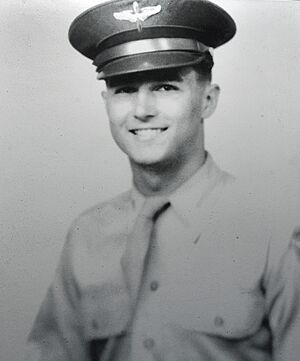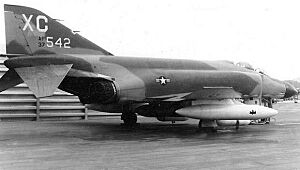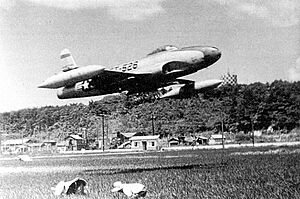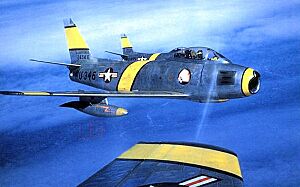Ralph Parr facts for kids
Quick facts for kids
Ralph Parr
|
|
|---|---|
 |
|
| Born | July 1, 1924 Portsmouth, Virginia, U.S. |
| Died | December 7, 2012 (aged 88) New Braunfels, Texas, U.S. |
| Buried |
Fort Sam Houston National Cemetery in San Antonio, Texas, U.S.
|
| Allegiance | United States |
| Service/ |
United States Army Air Forces United States Air Force |
| Years of service | 1942–1976 |
| Rank | Colonel |
| Unit | 49th Fighter Group 49th Fighter Bomber Wing 4th Fighter Interceptor Wing 12th Tactical Fighter Wing |
| Commands held | 4456th Combat Crew Training Squadron 4455th Combat Crew Training Squadron 12th Tactical Fighter Wing |
| Battles/wars | World War II Korean War Vietnam War |
| Awards | Air Force Cross Distinguished Service Cross Silver Star Legion of Merit (3) Distinguished Flying Cross (10) Bronze Star Medal Meritorious Service Medal Air Medal (41) |
Colonel Ralph Sherman Parr, Jr. (born July 1, 1924 – died December 7, 2012) was a brave American pilot. He was known as a "double-flying ace" during the Korean War. This means he shot down ten enemy aircraft in air battles. He also flew in World War II and the Vietnam War. Colonel Parr is the only person to receive both the United States Army Distinguished Service Cross and the United States Air Force's Air Force Cross. These are two of the highest awards for bravery in combat.
Contents
Early Life and Family
Ralph Parr was born in 1924 in Portsmouth, Virginia. His parents were Ralph Sherman Parr and May Parr. His father was a commander in the US Navy. He served in both World War I and World War II. Ralph also had a brother, Warren Sherman Parr, who became a rear admiral in the US Navy.
Military Career Highlights
Parr joined the U.S. Army Reserve in November 1942. He was accepted into the Aviation Cadet Program in February 1943. He earned his pilot wings and became a 2nd Lieutenant in the U.S. Army Air Forces in February 1944.
Flying in World War II
His first job was as an instructor pilot. He taught others how to fly from February to September 1944. After that, he trained to fly the P-38 Lightning aircraft. From April to August 1945, Parr flew P-38s in California. He then flew P-38s and later P-51 Mustangs with the 49th Fighter Group in Okinawa and Japan. He served there until July 1946.
After World War II, he left active duty. He joined the Air Force Reserve in September 1946. However, he was called back to active duty in February 1948. He flew P-51 Mustangs and F-84 Thunderjets until July 1950.
Korean War Missions
Parr became an F-80 Shooting Star pilot in July 1950. He was stationed in Japan and then deployed to Taegu Air Base in Korea. He flew many ground attack missions there until May 1951.
He later trained to fly the F-86 Sabre jet. He returned to Korea as an F-86 pilot in May 1953. He joined the 335th Fighter Squadron at Kimpo Air Base.
On June 7, 1953, Parr was flying over the Yalu River. He saw four Soviet MiG-15s and chased them. He then spotted 12 more MiGs. In the dogfight that followed, he destroyed two MiG-15s. He also damaged another before flying to safety.
On June 30, his flight encountered 16 MiG-15s. He managed to destroy two more MiGs. He then helped protect his wing commander from ten other MiGs, even though his fuel was low. For his brave actions, he received the Distinguished Service Cross.
During the Korean War, he flew 165 combat missions. He also helped create new ways to fight MiG-15s. He shot down a total of ten enemy aircraft. All of these victories happened in F-86 Sabres during the last seven weeks of the war.
On July 27, 1953, the war officially ended. On that very day, Captain Parr shot down an unarmed Soviet Navy transport plane. The plane was flying through North Korean airspace. Sadly, all 21 people on board were lost. The Soviet Union later tried to sue the U.S. over this incident.
After the Korean War
After the Korean War, Parr continued to serve. He flew F-86D Sabre Dogs for air defense until July 1958. He then worked as an operations staff officer. This included a time in the Netherlands from 1959 to 1962. He also commanded several combat crew training squadrons. He attended Air War College from 1966 to 1967.
Vietnam War Service

In September 1967, Parr became Deputy Commander for Operations of the 12th Tactical Fighter Wing. He was stationed at Cam Ranh Base in South Vietnam. He flew F-4 Phantoms during this time.
He earned the Air Force Cross during the siege of Khe Sanh in 1968. He bravely destroyed several enemy mortar and machine gun positions. He flew a heavily damaged F-4 and completed many dangerous passes. His actions helped protect friendly cargo planes and crews. The U.S. Marine Corps command at Khe Sanh even nominated him for the Medal of Honor.
After his first tour in Vietnam, he worked at Randolph Air Force Base. He returned to Vietnam for a second tour in March 1970. He served as Vice Commander and then Commander of the 12th Tactical Fighter Wing.
Later Career and Retirement
After Vietnam, Parr served in West Germany and Iran. His final assignment was as Director of Operations for the Tactical Air Warfare Center. This was at Eglin Air Force Base, Florida.
Colonel Parr retired from the Air Force in 1976. He had injured his back while inspecting damage to his home after a hurricane.
Personal Life
Ralph Parr was married to Margaret Parr for 40 years. Together, they had six stepchildren and ten grandchildren.
Death
Colonel Ralph Parr passed away on December 7, 2012. He was 88 years old. He died at an assisted living facility in New Braunfels, Texas. He was buried with full military honors at Fort Sam Houston National Cemetery in San Antonio.
Awards and Decorations
Colonel Parr is the only person to have received both the Distinguished Service Cross and the Air Force Cross. These are two of the highest awards for bravery in the U.S. military.
Here are some of his notable awards:
| US Air Force Command Pilot Badge | |||||||||||
| Air Force Cross | Distinguished Service Cross | ||||||||||
| Silver Star | Legion of Merit w/ 2 bronze oak leaf clusters |
Distinguished Flying Cross w/ Valor device, 1 silver and 2 bronze oak leaf clusters |
|||||||||
| Distinguished Flying Cross w/ 1 bronze oak leaf cluster (second ribbon required for accouterment spacing) |
Bronze Star | Meritorious Service Medal | |||||||||
| Air Medal w/ 4 silver oak leaf clusters |
Air Medal w/ 3 silver and 1 bronze oak leaf clusters (second ribbon required for accouterment spacing) |
Air Medal w/ 2 bronze oak leaf clusters (third ribbon required for accouterment spacing) |
|||||||||
| Air Force Commendation Medal | Army Commendation Medal | Air Force Presidential Unit Citation w/ 3 bronze oak leaf clusters |
|||||||||
| Air Force Outstanding Unit Award w/ Valor device, 1 silver and 1 bronze oak leaf clusters |
Air Force Organizational Excellence Award 1 bronze oak leaf cluster |
Combat Readiness Medal | |||||||||
| Army Good Conduct Medal | American Campaign Medal | Asiatic-Pacific Campaign Medal w/ 4 bronze campaign stars |
|||||||||
| World War II Victory Medal | Army of Occupation Medal w/ 'Japan' clasp |
National Defense Service Medal w/ 1 bronze service star |
|||||||||
| Korean Service Medal w/ Arrowhead device, 1 silver and 1 bronze campaign stars |
Armed Forces Expeditionary Medal w/ 1 bronze service star |
Vietnam Service Medal w/ 1 silver and 1 bronze campaign stars |
|||||||||
| Air Force Longevity Service Award w/ 1 silver and 1 bronze oak leaf clusters |
Armed Forces Reserve Medal | Small Arms Expert Marksmanship Ribbon | |||||||||
| Philippine Liberation Medal w/ 2 bronze service stars |
Philippine Independence Medal | Vietnam Gallantry Cross w/ Bronze Star |
|||||||||
| Vietnam Armed Forces Honor Medal 1st Class |
Republic of Korea Presidential Unit Citation | Republic of Vietnam Gallantry Cross | |||||||||
| United Nations Korea Medal | Vietnam Campaign Medal | Korean War Service Medal | |||||||||
See also
- List of Korean War flying aces



